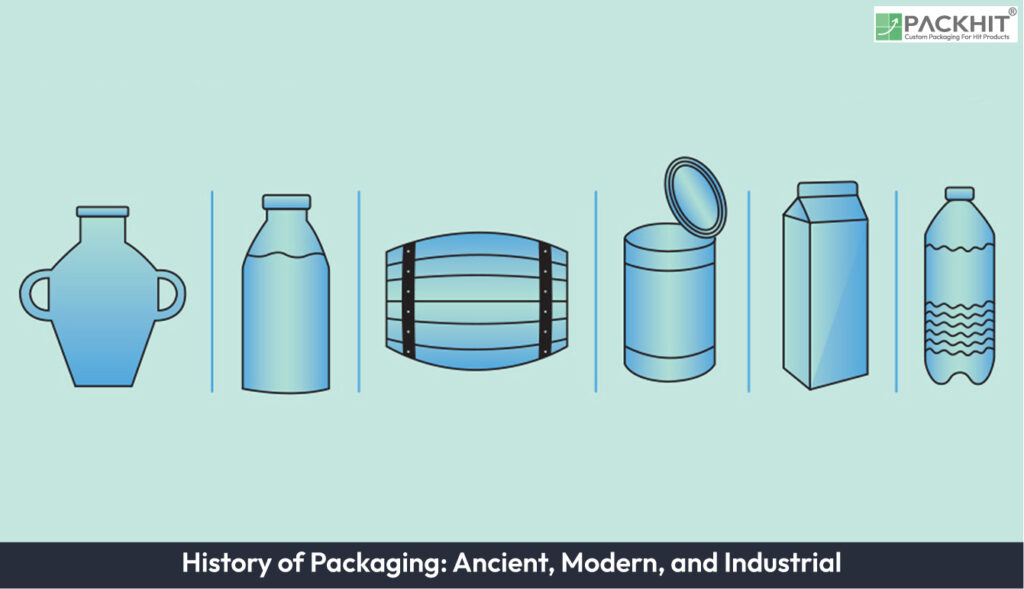The evolution of packaging mirrors the progression of human civilization, from using simple natural materials like leaves, animal skins, and gourds in ancient societies to the development of clay pots, woven baskets, and glassmaking techniques in subsequent eras. By the Middle Ages, advancements such as wooden barrels, parchment, and crates facilitated trade and storage, while the Industrial Revolution introduced transformative innovations like tin cans, paperboard, and corrugated cardboard, driven by mechanization and the need for mass production. The 20th century ushered in plastics, vacuum-sealing, and recyclable materials, revolutionizing packaging while addressing the growing demands of industrialization and environmental concerns.
Today, packaging integrates advanced materials, smart technologies, and sustainable solutions, with a focus on balancing functionality, consumer appeal, and ecological responsibility. Looking ahead, nanotechnology, IoT-enabled smart packaging, and circular economy principles are expected to shape the future, underscoring packaging’s role as a vital interface between products, consumers, and the environment.
- What Were the Earliest Forms of Packaging?
- How Did Packaging Evolve During the Middle Ages?
- What Innovations Defined Packaging in the Industrial Revolution?
- How Did Packaging Transform in the 20th Century?
- What Role Does Packaging Play in the Modern Industrial Era?
- What Does the Future Hold for Packaging?
What Were the Earliest Forms of Packaging?
The earliest forms of packaging were utilitarian and derived from natural materials. Archaeological evidence indicates that as early as 10,000 BCE, humans used leaves, animal skins, and hollowed-out gourds to store and transport food and water. By 3,500 BCE, the advent of pottery in Mesopotamia introduced durable clay containers, which were used for storing grains, oils, and liquids. At the same time, woven baskets made from reeds and grasses became common for carrying goods.
In ancient Egypt, glassmaking techniques emerged around 1,500 BCE, leading to the production of small glass vessels for perfumes and oils. Similarly, the Chinese developed paper as a packaging material by 100 BCE, primarily for wrapping food and preserving documents. These early innovations laid the foundation for more complex packaging systems in later civilizations.
How Did Packaging Evolve During the Middle Ages?
The Middle Ages saw incremental advancements in packaging, largely influenced by the growth of trade and commerce. Wooden barrels, first developed by the Celts around 350 BCE, became the dominant method for storing and transporting liquids such as wine, beer, and oil. These barrels were prized for their durability and ease of handling during long-distance trade.
In addition to barrels, parchment and wax-coated paper were used for wrapping perishable goods. The introduction of glassblowing in the Roman Empire around 50 BCE further expanded the use of glass containers, which were now more affordable and widely available. By the 13th century, merchants in Europe began using wooden crates and chests for shipping bulk goods, marking a shift toward more standardized packaging solutions.
What Innovations Defined Packaging in the Industrial Revolution?
The Industrial Revolution (18th–19th centuries) marked a turning point in packaging history, driven by advancements in manufacturing and material science. The invention of the tin can in 1810 by Peter Durand revolutionized food preservation, enabling the long-term storage and transport of perishable items. Concurrently, the development of paperboard in the early 19th century introduced lightweight, foldable packaging for consumer goods.
The rise of mechanized production also facilitated the mass production of packaging materials. For instance, the first corrugated cardboard box was patented in 1871, providing a cost-effective and durable solution for shipping fragile items. By the late 19th century, branding and advertising began to influence packaging design, with lithographic printing enabling colorful, branded labels on tin cans and paperboard boxes.
How Did Packaging Transform in the 20th Century?
The 20th century witnessed unprecedented innovation in packaging, driven by the demands of industrialization, globalization, and consumerism. The introduction ofplastics in the 1930s, particularly polyethylene and polypropylene, revolutionized packaging by offering lightweight, flexible, and moisture-resistant options. These materials became common in applications ranging from food wraps to beverage bottles.
During World War II, the need for efficient military supply chains led to the development of vacuum-sealed and aseptic packaging, which extended the shelf life of perishable goods. Post-war economic growth further accelerated packaging innovation, with the widespread adoption of aluminum cans, Tetra Pak cartons, and shrink-wrap films. By the 1970s, environmental concerns began to shape packaging practices, leading to the introduction of recyclable materials and biodegradable alternatives.
What Role Does Packaging Play in the Modern Industrial Era?
In the modern industrial era, packaging serves as a critical component of global supply chains, balancing functionality, sustainability, and consumer appeal. Advanced materials such as multi-layer laminates and smart packaging technologies have enabled enhanced product protection, tamper resistance, and traceability. For instance, Radio-frequency identification (RFID) tags and QR codes are now integrated into packaging to provide real-time tracking and consumer engagement.
Sustainability has emerged as a dominant theme in contemporary packaging design. Manufacturers are increasingly adopting paper-based materials, such as corrugated cardboard and molded pulp, to reduce plastic waste. Innovations in biodegradable polymers and reusable packaging systems are also gaining traction, reflecting a shift toward circular economy principles.
What Does the Future Hold for Packaging?
The future of packaging is likely to be shaped by advancements in material science, digital technology, and environmental policy. Nanotechnology is expected to play a significant role, enabling the development of ultra-thin, high-strength materials with enhanced barrier properties. Smart packaging, incorporating sensors and Internet of Things (IoT) connectivity, will further enhance supply chain efficiency and consumer interaction.
Sustainability will remain a key driver, with increased emphasis on compostable materials, zero-waste designs, and closed-loop recycling systems. Regulatory frameworks, such as extended producer responsibility (EPR) laws, will compel manufacturers to adopt more sustainable practices. As packaging continues to evolve, it will remain a vital interface between products, consumers, and the environment.

